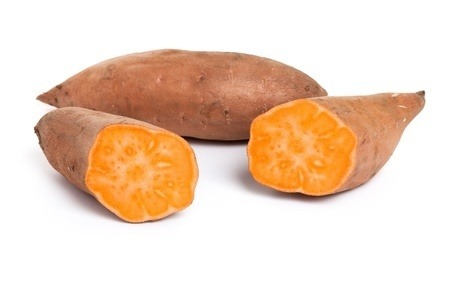
- Sweet potatoes have a remarkably vivid orange flesh which is rich in carotenes, especially vitamin A precursors.
- It could be the answer to resolving vitamin A deficiencies in populations throughout the third world.
The good old sweet potato unlike its regular counterpart potato contributes to your five a day. In fact half an average sized sweet potato counts as one of your fruit & veg. portions per day.
The consumption of sweet potato (Ipomoea batata (L.) Lam.) has steadily risen because of its appeal as a base for a variety of dishes such as tagines and casseroles. In fact, we cook it like ordinary potatoes and have it as chips or mash too. But what has it to do with vitamin A ? It was realised in 2001 that vitamin A malnutrition might be combated effectively by consumption of orange-fleshed sweet potato (OFSP) in sub-Saharan Africa (Low et al., 2001). Then in 2011, the WHO (World Health Organisation) reported that vitamin A deficiency (VAD) affected about 190 million young children and about 19 million pregnant women throughout the third world. Resolving this issue has been one of those major priorities for the organisation but finding a non-intervention approach has proven elusive so far (Burri, 2011).
Vitamin A Deficiency
Vitamin A deficiency amongst other types of low mineral and vitamin uptake in the diet can lead to poor immunity, abnormal growth and development in the young and this starts in the womb (van Jaarsveld et al., 2005). Children who are vitamin A deficient have a lower resistance to common infections such as respiratory and diarrheal diseases, measles, and malaria (Rice et al., 2004). Many South and South-East Asian countries and those in sub-Saharan Africa are badly affected by this absence of high quality nutrition in the young. Countries in east and southern Africa have a high prevalence – about 37% of preschool children with very low serum retinol concentrations. India is especially hampered suffering the highest prevalence of clinical and sub-clinical vitamin A deficiency in up to 60% of its pre-school children. In Bangladesh, vitamin A deficiency is about 20.5% overall in preschool children which rises to 38.1% in the slum and less well off regions.
Sweet potato may resolve the issue low vitamin A in the diet. Generally, in the developing world, many people can only purchase poor quality fruit and vegetables which are low in nutrients even though they are relatively cheap. Unfortunately, consumption is also hampered by a poor supply chain and distribution. About 100 million Tonnes of sweet potato are grown every year and so it is already a staple crop which could see its production rise because of the suggestion that ingestion of vitamin A levels might alleviate deficiencies more effectively (FAOSTAT, 2012). It is important to note that white-fleshed sweet potato does not provide as much vitamin A as the orange-fleshed varieties (van Jaarsveld et al., 2005). The vitamin A content of orange fleshed varieties is close to 60 μg per g dry weight. Greater levels of cultivation of the orange-fleshed type is needed and typical varieties include Resito, Kamalsundari and BARI SP-5 although there are many other varieties available.
Carotenoid Levels In Sweet Potatoes
Recently, it was reported that sweet potatoes contain a high content of various carotenoids including the nutritionally valuable cis- and trans– ß-carotenes which are retained even when the vegetable is boiled. Raw sweet potato can be eaten but in the process of heat treatment, some of those valuable vitamin A precursors are lost. The trans- ß-carotene is the major carotenoid in raw sweet potato but is converted to the cis- form when boiled.
A number of studies have compared the carotenoid levels between white and orange fleshed varieties before and after processing. The latest study was conducted at the Institute of Nutrition and Food Science (University of Dhaka, Bangladesh) in conjunction with the Nutritional Biochemistry Laboratory of the International Centre for Diarrheal Disease and Research in the same country. In this study, the cultivar Kamalasundari was one of the richest in vitamin A (62 μg per g dry weight) which dropped by about 3 μg per g dry weight when the vegetable was boiled. Their analysis relied on isolation of the carotenoids using an acetone-petroleum ether extraction followed by spectrophotometric analysis. Reversed-phase HPLC was the conventional method employed to separate the trans– from the cis-ß– carotenes with a mobile phase based on acetonitrile, methanol and 2-propanol.
It’s just worth noting that it also has a high vitamin C content – so something else positive to think about when chomping on this vegetable.
References
Burri, B. J. (2011). Evaluating sweet potato as an intervention food to prevent vitamin A deficiency. Comprehensive Reviews in Food Science and Food Safety, 10(2), pp. 118-130.
Islam, S.N., Nusrat, T., Begum, P. Ahsan, M. (2016) Carotenoids and β-carotene in orange fleshed sweet potato: A possible solution to vitamin A deficiency. Food Chem. 199 pp. 628-631 doi:10.1016/j.foodchem.2015.12.057
Low, J., Walker, T., Hijmans, R., (2001) The potential impact of orange-fleshed sweet potatoes on vitamin A intake in Sub-Saharan Africa. Paper presented at a regional workshop on food-based approaches to human nutritional deficiencies. The VITAA Project, vitamin A and orange-fleshed sweet potatoes in Sub-Saharan Africa, 9–11 May, Nairobi, Kenya. Retrieved May 01, 2014 after private communication.
FAOSTAT. (2012). Available from http://faostat.fao.org/site/ 339/ default.aspx. Accessed March 23rd, 2012
Rice, A.L., West Jr., K.P., Black, R.E., (2004) Vitamin A deficiency. In: Ezzati, M., Lopez, Rice, A.D., Rodgers, A., Murray, C.J.L. (Eds.), Comparative Quantification of Health Risks. Global and Regional Burden of Disease Attributable to Selected Major Risk Factors. World Health Organization, Geneva
van Jaarsveld, P.J., Faber, M., Tanumihardjo, S.A., Nestel, P., Lombard, C.J., Benade, A.J.S., (2005). b-carotene-rich orange fleshed sweet potato improves the vitamin A status of primary school children assessed with the modified-relative-dose response test. Amer. J. Clin. Nutr. 81, pp. 1080–1087.


Leave a Reply